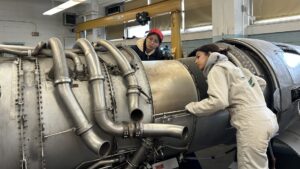Bridging the Skills Gap in Aviation: Challenges and Opportunities
At Extreme Investor Network, we delve deep into the nuances of business landscapes, uncovering unique insights and opportunities. Today, we’re shining a spotlight on a pressing issue within the aviation industry: the critical shortage of skilled aircraft technicians. As manufacturing jobs in the U.S. shift and evolve, understanding these challenges is paramount for investors and industry stakeholders.
The Current Landscape: A Looming Crisis
In the heart of Lafayette, Indiana, a crisis brews that could have far-reaching consequences for the aviation sector. Recent data reveals that the average age of a certified aircraft mechanic in the U.S. is 54, with a staggering 40% of these technicians aged 60 or above. By 2028, the United States could face a shortfall of 25,000 aircraft technicians. This shortage is not merely a statistic—it’s a reality that airlines and manufacturers must confront head-on.
David Seymour, Chief Operating Officer of American Airlines, highlighted the implications of an aging workforce: “Many technicians were hired during the ’80s and early ’90s, so the retirement wave is imminent.” With the aviation sector poised for growth, the need for fresh talent is more urgent than ever.
A History of Talent Loss
Before the COVID-19 pandemic, the aerospace industry was already experiencing a recruitment challenge. The pandemic exacerbated this by prompting layoffs and early retirements of experienced technicians. Christian Meisner, GE Aerospace’s Chief Human Resources Officer, put it succinctly: “We lost a lot of talent.”
As companies scramble to ramp up hiring, they must also contend with a complex ecosystem of smaller suppliers who have struggled to recover from the pandemic’s impact. The ripple effects of this labor shortage extend to other critical roles, including air traffic controllers, further complicating the landscape for airlines.
The Economic Tilt: Booming Salaries
Despite the challenges, the opportunities in the aviation sector are vast. Current median salaries for aircraft mechanics hover around $79,140, significantly above the national median income. Companies like American Airlines are incentivizing talent by promising salaries upwards of $130,000 for top technicians within nine years of employment.
This is just the beginning. As demand for air travel surges, hiring and wage pressures are likely to intensify. Coupled with the complexities of aviation regulatory requirements, this sector presents a compelling case for both employment opportunities and potential investment.
Acknowledging the Geographic Constraints
One noteworthy challenge is the geographical immobility of workers. As noted by Gordon Hanson, a professor of urban policy at Harvard University, "Workers aren’t very geographically mobile." This places added pressure on local labor markets to meet the growing demands of the aviation industry.
As the unemployment rate remains steady, companies must find innovative ways to attract talent from nearby communities or risk falling short of their hiring goals.
The Future: Cultivating the Next Generation of Technicians
Looking ahead, educational institutions like Aviation High School in Queens, New York, are rising to the occasion by nurturing the next generation of aircraft technicians. The school has witnessed a surge in applications, reflecting an increasing interest in this rewarding career path. Students are even opting for hands-on training over traditional college degrees—an encouraging sign for an industry in desperate need of skilled workers.
Moreover, initiatives are underway to introduce aviation careers to junior high students, exposing them to high-tech environments and motivating them to pursue these vital roles.
Conclusion: An Invitation to Invest in the Future
At Extreme Investor Network, we believe that understanding these shifting dynamics not only informs strategic investment decisions but also empowers stakeholders to make impactful choices. As the aviation industry navigates this workforce crisis, there lies a unique opportunity for those willing to invest in innovative training programs and infrastructure.
In conclusion, bridging the skills gap in aviation will require collaboration among educational institutions, airlines, and manufacturers. The future may be uncertain, but this is a challenge that, when met with the right solutions, can lead to an unprecedented boom in one of America’s most essential industries.
Stay informed and engaged with us at Extreme Investor Network for more insights on navigating the evolving business landscape. Your next investment could be in the future of aviation.

